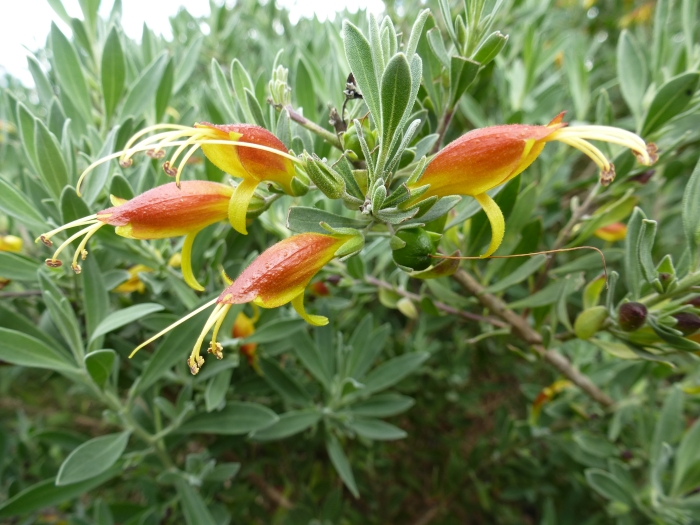Tar Bush
(Eremophila glabra)
Tar Bush (Eremophila glabra)
/
/

Geoff Derrin
CC BY-SA 4.0
Image By:
Geoff Derrin
Recorded By:
Copyright:
CC BY-SA 4.0
Copyright Notice:
Photo by: Geoff Derrin | License Type: CC BY-SA 4.0 | License URL: https://creativecommons.org/licenses/by-sa/4.0 | Uploader: Gderrin | Publisher: Wikimedia Commons | Title: Eremophila_glabra_flowers.JPG | Notes: |






















Estimated Native Range
Summary
Eremophila glabra, commonly known as Tar Bush, is a versatile and hardy shrub native to a wide range of habitats in Australia, including arid inland areas, woodlands, and coastal dunes. It is a member of the Scrophulariaceae family and exhibits significant morphological variation, with some forms being low and ground-hugging while others are more erect. This shrub typically grows to a height of 0.1–3 m (0.3–10 ft) and can be either prostrate or upright in form. The flowers of Tar Bush are particularly notable, coming in shades of red, orange, yellow, or yellowish-green, and are borne singly or in pairs in the leaf axils on stalks 3–10 mm (0.1–0.4 in) long. The flowering season extends from early autumn to summer (March to December in Australia), and the flowers are followed by oval to almost spherical fruits that are glabrous, dry or fleshy, and dark brown.
Tar Bush is highly valued for its low maintenance requirements, drought tolerance, and the ability to provide year-round interest in native gardens. Its variability allows gardeners to create a diverse display with a single species. It is commonly used in xeriscaping, as ground cover, and in rockeries. Eremophila glabra thrives in a range of soils and tolerates full sun to full shade. While most forms are frost-hardy and drought-resistant, some hairy-leaved varieties may not withstand high humidity. Cultivars like "Kalbarri Carpet" and "Murchison Magic" offer additional ornamental appeal. In cultivation, it does best with low water and medium drainage.CC BY-SA 4.0
Tar Bush is highly valued for its low maintenance requirements, drought tolerance, and the ability to provide year-round interest in native gardens. Its variability allows gardeners to create a diverse display with a single species. It is commonly used in xeriscaping, as ground cover, and in rockeries. Eremophila glabra thrives in a range of soils and tolerates full sun to full shade. While most forms are frost-hardy and drought-resistant, some hairy-leaved varieties may not withstand high humidity. Cultivars like "Kalbarri Carpet" and "Murchison Magic" offer additional ornamental appeal. In cultivation, it does best with low water and medium drainage.CC BY-SA 4.0
Plant Description
- Plant Type: Shrub
- Height: 1-10 feet
- Width: 1-10 feet
- Growth Rate: Moderate, Rapid
- Flower Color: Yellow, Orange, Red
- Flowering Season: Fall, Winter, Spring
- Leaf Retention: Evergreen
Growth Requirements
- Sun: Full Sun, Part Shade
- Water: Low
- Drainage: Medium
Common Uses
Bank Stabilization, Bee Garden, Bird Garden, Butterfly Garden, Groundcover, Hedges, Hummingbird Garden, Low Maintenance, Potted Plant, Showy Flowers, Street Planting
Natural Habitat
Native to a wide range of habitats in Australia, including arid inland areas, woodlands, and coastal dunes
Other Names
Common Names: Common Emubush, Fuchsia Emu Bush
Scientific Names: , Eremophila glabra, Bondtia glaber, Bontia glabra, Eremophila brownii var. viridiflora, Stenochilus glaber var. viridiflorus,
GBIF Accepted Name: Eremophila glabra (R.Br.) Ostenf.